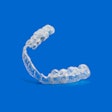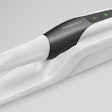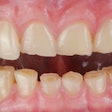In an effort to find ways to reduce dental implant failure rates, a researcher from Griffith University has used computer modeling software to study the stress created in the mandible during and after the placement of titanium implants.
While dental implants are gaining popularity and new materials and production methods are improving the technology, a 5% failure rate is still believed to be associated with incorrect insertion techniques and a lack of understanding of the complex stress characteristics within the jawbone, according to Rudi van Staden, Ph.D.
Using medical imaging methods, he created a 3D computer model of the human jawbone and implant, and simulated the dynamic implantation process.
"It is very easy to use the incorrect technique when placing the implant into the jawbone, which can lead to undesirable stresses," van Staden said in a university press release. "If that happens, then the jawbone will not biomechanically bond with the implant and this can result in instability or even failure."
He is now planning to advance the analysis technique of the implantation method and build a treatment planning database tool that dentists can use.
Copyright © 2010 DrBicuspid.com







.DpIowD0Qsf.png?crop=focalpoint&fit=crop&fp-x=0.5&fp-y=0.5&h=167&w=250&auto=format%2Ccompress&q=70)











